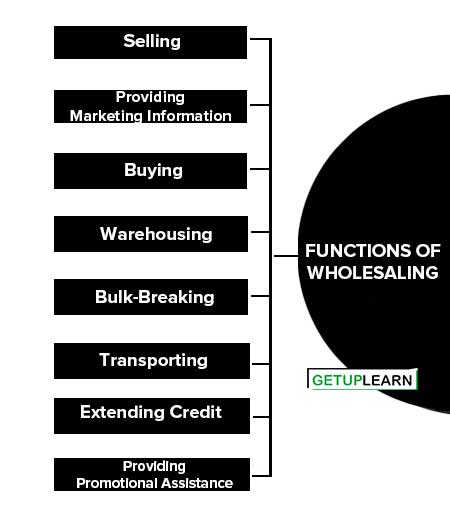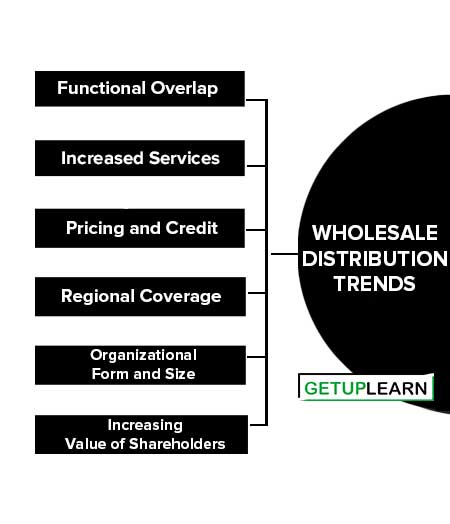Table of Contents
What is Wholesaling?
They simplify the product and information flows between the manufacturer and the end users. Maintain large inventories of goods that are both uneconomical and impractical for Manufacturers. Unlike agents, wholesalers take title to the goods and services that they are intermediaries for. They are independently owned, and they own the products that they sell.
Functions of Wholesaling
Discussed below are the functions of wholesaling:
- Selling
- Providing Marketing Information
- Buying
- Warehousing
- Bulk-Breaking
- Transporting
- Extending Credit
- Providing Promotional Assistance

Selling
In order to provide retailers with products, the wholesaler must have a well-trained sales force to visit the retailers and potential buyers to establish business relationships.
Wholesaler’s sales representatives make regular visits to retail store buyers, industrial firms, schools, hospitals, etc. They carry samples, catalogs, and displays that show the wholesaler’s complete line of products.
Providing Marketing Information
Wholesalers are in contact with many retailers/buyers and can be a valuable resource of information to the retail industry about trends in each industry.
Buying
To be able to stock the products that the retailers/buyers want, the wholesaler studies fashion trends, consumer demand, and retail prices. This research enables the wholesaler to buy the product that the retailer will most likely want and in the right quantities.
Warehousing
This is the process of storing goods in one place. The wholesaler provides the service of warehousing the product that the retailer wants. The retailer does not have the space for storage and can order products from the wholesaler as needed.
Bulk-Breaking
This is the process of dividing large shipments into smaller ones. This is a service provided by the wholesaler that is advantageous to the manufacturer and the retailer. Manufacturers don’t want to deal with small deliveries, and retailers can’t afford big orders. The wholesaler is the perfect middleman in this instance.
Transporting
Large, frequent deliveries can be made to wholesalers from the manufacturers. If the manufacturer had to deliver to all surrounding retailers who purchased its goods, it would be very costly and the delivery would be unpredictable. Wholesalers pass along the savings of transportation costs to retailers in smaller shipments.
Extending Credit
Retailers may pay wholesalers for merchandise with the money earned from the sale of that same merchandise. An example of this would be a retailer ordering Easter decorations in January, and not paying for them until May. This is known as extending “terms” for payment, such as 2/10, net 30.
Providing Promotional Assistance
A variety of promotional assistance ranging from help in designing the store layout to sharing in the costs of local advertising may be offered by the wholesaler. This is called cooperative advertising.
Types of Wholesalers
The evolution of distribution channels was accompanied by the introduction of several intermediaries in the distribution channel to make the products easily available to the end users.
The period also saw an increase in the types of intermediaries to meet the growing needs of the customers as well as producers. The major types of wholesalers are as follows:
Merchant Wholesalers
Their businesses are independently owned and the title is taken to the merchandise they handle. Full-service and limited-service jobbers, distributors, and mill supply houses come under this category.
Full-Service Wholesalers
They carry stock, maintain a sales force, offer credit, make deliveries, and provide management assistance. Wholesale merchants sell to retailers and industrial distributors sell to manufacturers and provide credit and delivery services.
Limited-Service Wholesalers
Cash and carry wholesalers sell a limited line of fast-moving goods to small retailers, truck wholesalers sell and deliver a limited line of semi-perishable goods to supermarkets, grocery stores, hospitals, restaurants, hotels, drop shippers provide services to bulk industries such as heavy equipment, coal, etc., mail- order wholesalers help to send catalogs to retail, industrial and institutional customers by mail, rail, plane or truck.
Specialized Wholesalers
Agricultural assemblers, petroleum bulk plants and terminals, and auction companies fall under specialized wholesalers.
Limitations of Wholesaling
The highly competitive marketplace, changing customer preferences, disintermediation, i.e., direct selling without intermediaries, and e-commerce has made it necessary for wholesalers to design innovative strategies to survive in the business.
- Target Market Decision
- Marketing Mix Decisions
- Product of Offer
- Product Pricing
- Products Positioning
- Promotion
- Place

Target Market Decision
Like in any other business, there is a need for wholesalers also to identify their target market. The target market comprises an identified group of customers upon whom the wholesaler can focus for the bulk of his business transaction.
The target for a wholesaler can be identified on the basis of size (large, medium, or small retailer), type of customer (urban or rural), distance from the wholesaler’s location (within city limits, within a radius of 100 miles, 300 miles, etc), income range of the customer (high income, or low income) or requirements to fulfill in terms of products and services offered.
Marketing Mix Decisions
Yet another key area that requires strategic decision-making by the wholesaler is the marketing mix. Wholesalers must decide on the products to offer, their pricing and positioning, the promotional activities required, and the means to reach the target market.
Product of Offer
A wholesaler must decide on the assortment of products to offer to his customer. Wholesalers should carefully analyze are profitability. Wholesalers should thus maintain a profitable assortment of products.
Product Pricing
The pricing activity involves calculating a break-even price. This requires computing the variable and fixed costs the wholesaler incurs on purchasing merchandise from the manufacturer and storing it.
The selling price can be calculated by dividing the sum of the variable and fixed costs by the number of units to be sold. Wholesalers add a standard markup to the cost of goods to cover the expenses incurred on transporting, packaging, assorting, etc.
Products Positioning
Wholesalers have to find ways to clearly differentiate their products from others available in the market.
Promotion
Promotional activities aim at increasing the brand awareness of the customer and persuading them to buy the products. Promotional activities also help a customer become brand loyal in the case of high-quality products.
Place
The products have to be made available at places that are convenient to customers. Wholesalers have to take into consideration the transportation costs involved as well as the customer reach as criteria for taking the place decision.
Wholesale Distribution Trends
The wholesaler business has been moving upward for the past 20 years. The growth of wholesaling has been driven by changes in business investment, especially in the case of producing durable goods & equipment, and changes in household consumption, which influence the orders generated in the distribution channels.
The basic trends that are responsible for bringing about a significant change in the business of wholesaling are discussed below:
- Functional Overlap
- Increased Services
- Pricing and Credit
- Regional Coverage
- Organizational Form and Size
- Increasing Value of Shareholders

Functional Overlap
The dynamic nature of markets has caused an overlap of functions between the various levels as a result of which there is no longer a sharp demarcation between them in the present-day markets scenario.
Wholesale-retail franchising, joint ventures, and conglomeration have given rise to horizontal and vertical market integration, which has further reduced the distinction among the intermediaries in the marketing channel.
Increased Services
Wholesalers have re-designed their services over time to suit customer requirements. A number of wholesale druggists in the U.S. now handle the customer records of retail druggists. This service binds the retailers to one wholesaler.
In the grocery business, for instance, wholesalers have shifted their focus from providing basic services like an extension of credit to offering more sophisticated services such as merchandising support, inventory management counseling, conducting profit analysis further retailers, etc.
Pricing and Credit
The pricing of a product or a service is a critical element as the price influences the customer’s decision to buy. The wholesalers in keeping with this concept constantly work to arrive at a price that maximizes the value offered by the products.
They are constantly on the lookout for better pricing mechanisms’; such as systems contracting that offer better services to customers at a lower cost. Another key factor in attracting customers is the credit terms that the wholesaler offers. The quest of wholesalers for new pricing mechanisms and credit alternatives has brought about a signification change in wholesaling over the years.
Regional Coverage
Wholesalers use their subsidiaries to cater to the needs of the local market segments by storing limited fast-moving inventory. These outlets have access to a centralized warehouse to meet their inventory demands. This is a common practice in the distribution of plumbing, heating, and cooling equipment.
Wholesalers are also making use of a leapfrogging strategy that involves implementing backfire tactics. Under this strategy of market penetration, the wholesalers set up branches that are about 1000 miles away from the main office so that sales spread backward towards the home base.
Organizational Form and Size
In the past, the wholesale market was dominated by sole proprietorships, partnerships, and family-run businesses. The current trend among wholesaling establishments has been to grow in size and assume a corporate form.
Wholesalers have moved towards assuming a corporate form through the options of public finance, takeovers, and mergers & acquisitions.
Wholesalers have an increasing interest in enhancing value for their shareholders. Favorable tax laws have made them more open to diluting their stake through public financing and employee stock options.
The trends just discussed show wholesalers’ responsiveness to market forces and how they transformed themselves to meet the growing demands of both manufacturers and resellers for improved service at lower costs.
FAQs About the Wholesaling
What are the functions of wholesaling?
The functions of wholesaling are given below:
1. Selling
2. Providing Marketing Information
3. Buying
4. Warehousing
5. Bulk-Breaking
6. Transporting
7. Extending Credit
8. Providing Promotional Assistance.
What are the types of wholesalers?
These are the four major types of wholesalers: Merchant Wholesalers, Full-Service Wholesalers, Limited-Service Wholesalers, and Specialized Wholesalers.

